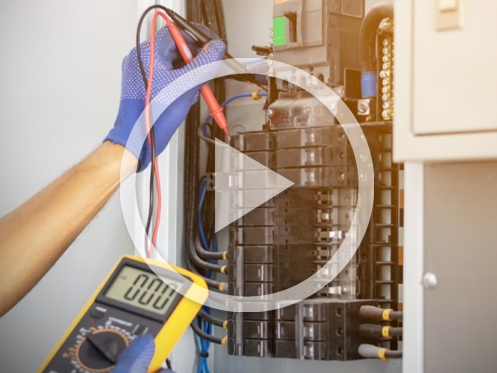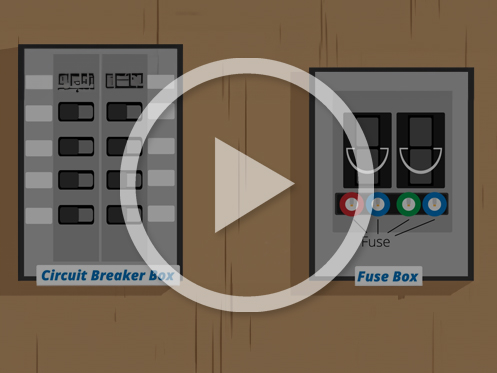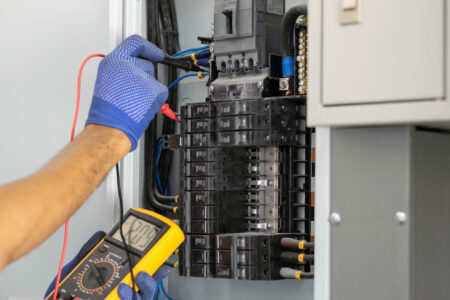Updated January 22, 2024
Considering a whole-home surge protector? As with any home improvement investment, especially in the case of home protection and safety, it’s helpful to know the benefits before paying up.
Let’s look at the advantages of installing a whole-home surge protector in your Iowa home as well as what features to look for:
- What Does a Whole-Home Surge Protector Do?
- Protect Your Home’s Appliances and Technology
- Protect Your Home’s Electrical System
- What to Look for in a Surge Protector
First, let’s review the purpose of a surge protector, how it works, and what triggers electrical surges before getting into its benefits.
Contact Golden Rule PHC for a Reliable Whole-Home Surge Protector Installation
Protect your appliances and electronics with the latest whole-home surge protectors installed by your friends at Golden Rule PHC. We complete 99% of our installations for Des Moines Metro homeowners in just one visit, plus we offer the best guarantees and warranties in the state of Iowa. Call us today at 515-393-4526 for same-day service!
What Does a Whole‑Home Surge Protector Do?
Whole-home surge protectors monitor the electrical current flowing through your home’s wiring. It connects to your home’s main circuit breaker and essentially lets in safe electrical currents but filters out dangerously high currents or voltages from frying your home’s electrical system and causing potential fires.
Some causes for electrical surges include blackouts, downed power lines, thunderstorms, damaged wiring, or large appliances starting up or shutting down. The last cause is especially common, and we’ll review the benefits of a surge protector regarding it.
For example, in the event of one of Iowa’s frequent thunderstorms, indirect lighting strikes produce electrical surges. When a surge current reaches unsafe voltage levels, the surge protector diverts the excess voltage into the ground via a ground wire away from your home.
Let’s look at how we can better protect your home’s appliances, technology, and electrical systems.
Protect Your Home’s Appliances and Technology
Internal surges are those caused by electrical appliances. According to the National Electrical Manufacturers Association, they are transient and account for 60-80% of all surges that occur in a home.
Typically, electrical appliances require a lot of “juice” to start up or shut down their motors. In doing so, they can divert electricity from or to other appliances and disrupt the flow of electricity, causing an internal surge. These surges are so short that you might not even notice that they happened. However, over time, these internal surges can damage and shorten the lifespan of your home’s appliances and electronics.
Technology is also at risk with the many electronic devices homeowners use. All of these gadgets use circuits that can be vulnerable to power surges. If you have any of the below electronic devices, it’s worth installing a surge protector:
- Desktop computers
- Gaming equipment
- Humidifiers/HVAC systems
- Laptops/tablets
- Laundry washer/dryer
- LED strips and other lighting equipment
- Refrigerators
- Smartphones
- Televisions
Whether you’re dealing with a thunderstorm, power outage, or tripped circuit breaker, installing a whole-home surge protector prevents internal surges, protecting your home’s appliances and technology from damage and keeping them performing at their best for as long as possible.
Protect Your Home’s Electrical System
Beyond your electronics and appliances, a whole-home surge protector can also protect your electrical system. For instance, the surge protector diverts voltage away, preventing spikes and surges from damaging your home’s electrical wiring, sockets, circuits, and panels. That way, you save money on electrical repairs and replacements.
Saving money on electrical repair costs is vital when whole-home electrical rewiring can cost anywhere from $8,000 to $30,000+. Not to mention that many homeowner insurance companies have specific policies about what they will cover in the event of personal property damage caused by an electrical surge.
What to Look for in a Surge Protector
Now that you know the peace of mind a surge protector can bring (preventing thousands of dollars in damage to appliances, technology, and your electrical system), let’s look at the three features you want to look for when buying one:
- Joule’s capacity: Surge protectors can absorb a certain amount of this unit of energy before it is at capacity. The higher the surge protectors Joules capacity, the better it protects your electrical system, appliances, and technology.
- Voltage protection rating (VPR): The VPR is the baseline voltage for what a surge protector will filter out. You’ll want to find a surge protector with a low VPR rating so that it kicks in earlier.
- Response time: Immediate diversion of unsafe voltage is vital for protecting your home. You’ll want to look for a surge protector with a nanosecond response time or even less.
Ready to Protect Your Home and Appliances with a Whole-Home Surge Protector Installation? Contact Golden Rule.
At [company_name] PHC, we train our electricians in-house. When Des Moines Metro homeowners call us for service, they know they’ll receive a highly skilled professional at their door for a whole-home surge protector installation. We pride ourselves on our fast response times, high-quality standards, and reliable service. From installing the latest whole-home surge protectors in just one visit to offering the best guarantees and warranties in Iowa, we strive to provide you with the best electrical service possible.
Contact us today or call us at 515-393-4526 for 5-star service!
Contact Us Today for Electrical Service!
If you found this post helpful, check out the importance of residential electrical inspection:



